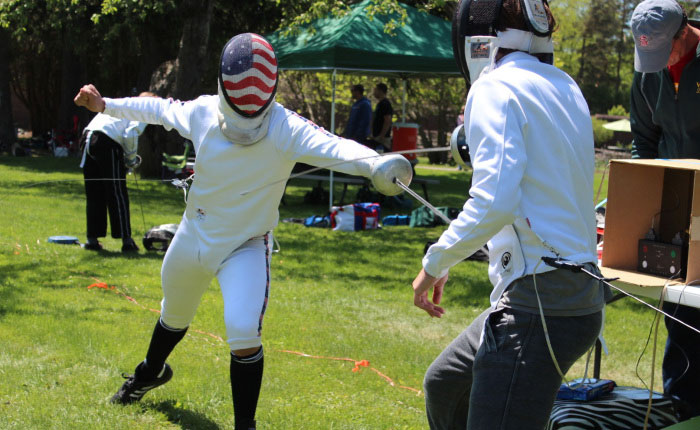Getting to the point
Warm sunlight streams into the courtyard, the four walls of the ancient fort rising high above the large crowd of silent spectators. The only sound is the sharp clang of metal blades echoing off the surrounding brick walls.
The afternoon light illuminates two people wielding shiny silver swords, large bell guards glinting. Both swordsmen breathe heavily, their blade tips fixated toward each other as dirt, kicked up by their darting footwork, swirls through the air.
Suddenly, one swordsman lunges forward, thrusting the blade tip toward their opponent. With a flick of their wrist, the opponent whips their own blade up to meet the other, pushing aside the oncoming attack, smoothly leaning into a lunge, plunging forward with fluid grace, the tip of their blade rushing forward.
In the Olympics, the tip of a fencing sword is the second fastest object after the bullet. In the sport of fencing, even a split second of hesitation determines the ultimate outcome of a bout.
Toward the end of May, my fencing coach, who is known as Digger for his years of pirating a video game of that name throughout his college career, and I pack our fencing bags and head down to Fort Ticonderoga in New York, along the south end of Lake Champlain.
Our tradition stretches all the way back to spring of 2013, a year after I started fencing when I was 16 years old. Now, almost seven years later, taking the nearly two-hour road trip to the historical site is still a yearly tradition of ours.
Over the years, road tripping to fencing tournaments has been a huge part of our bonding experience as teacher and mentor, as well as friends, and we always bring along plenty of good music, snacks and conversations to get the full road trip experience.
The tournament is also a great way to catch up with all of our friends and fellow fencers within the Vermont Fencing Alliance and connect with new fencers. It is a celebration to bring the fencing season to a close, and the tournament draws in fencers and fencing clubs from all over New England and beyond.
This is a great opportunity for both of us to challenge ourselves by competing with unfamiliar fencers, adapting and strengthening our fencing skills to new styles and techniques. The tournament hosts a youth event, a women’s event and an open event, which anyone is welcome to compete in.
Fencing is a sport and art form that stretches back centuries, its origins rooted in the civilian rapier sword found throughout Spain in the late 1400s. Since the beginning of modern fencing in the 1800s, the sport has played a number of roles within society, including in military training, as an extracurricular activity at boarding schools and universities, and as an Olympic sport.
Today, it is practiced by millions throughout the world within clubs and teams. Strength, precision, dexterity, balance, and analytical and problem-solving skills are all necessary components to making a skilled fencer.
The event starts out on the grassy lawn next to the shoreline of the lake and directly next to the King’s Garden, a beautiful flower garden enclosed by red brick walls in the small valley below the fort.
Dozens of fencers clad in white jackets, white trousers and mesh helmets face off on a dozen different strips across the lawn, worn down to dirt strips by footwork. Some spectators and fencers resting between bouts lounge on lawn blankets, enjoying the warm spring weather. My fencing coach and I always make sure to bring along a large picnic to enjoy between the exhaustive bouts. If everyone were not brandishing large and intimidating swords, the scene would be reminiscent of a garden party from the Victorian era, everyone dressed in their best ivory-white suits and dresses.
An old white colonial-style house sits next to the garden, shaded by large oak trees, their bright green leaves shuddering gently in the spring breeze. A tent is set up alongside the house, featuring a table covered in a variety of fencing gear, an assortment of colorful ribbons and an intricately designed sheathed rapier sword, the coveted prize for the first-place winner of the tournament that is passed on each year.
Every year attending this tournament, I am filled with excitement and a giddy joy from the positive energy that is palpable throughout the crowds of fencers. Some years, I have not participated in the competition, simply bringing along my Canon DSLR camera to photograph the incredible action taking place.
The bouts are fierce and visceral, the fencers darting up and down the grassy strips, their blades twisting, turning, clanging, barely weaving in and out of each other’s reach. It is a mesmerizing dance, punctuated intermittently by a shout from a fencer, a “Halt!” from the referee and the buzz of the score box.
Grass and dirt stains, strikingly obvious on the bright white knickers, begin to become more and more common throughout the afternoon. The fencers remove their helmets after each bout, saluting blades and shaking sweaty hands out of respect for each other. Showing genuine respect for your opponent, no matter how the bout concluded, is at the core of fencing etiquette.
Other years, I have taken part in the tournament myself, Digger being the perfect companion and resource to exchange coaching advice, fist bumps, witty banter and humorous observations with between each of our bouts.
When I step up to the strip, I take a deep breath. I am already sweating under my thick jacket, bursting with energy as I bounce on the tips of my toes, stretching my neck and shoulders.
The mask is claustrophobic and somewhat suffocating, the mesh front distorting my vision as if I were looking through a window screen. However, I am quite used to this after years of fencing. “On guard,” commands the referee, and my opponent and I go into on guard stances. “Fencers ready? Fence!”
Bouts usually start out slow, both fencers figuring out their opponent’s style, analyzing the best angle and tactics to take.
We dart backwards and forwards along the strip as I blink back the salty sweat dripping into my eyes. Seeing an opening under my opponent’s elbow, I push forward, my blade twisting forward as I fall into a deep lunge, my right knee thrusting forward, my muscles screaming. My opponent parries, pushing my blade aside as they retreat wildly. Whipping my blade around I catch theirs, rotating my wrist to redirect the tip over my shoulder. Continuing with a double lunge, I thrust forward, my blade’s tip striking them on the chest. “Halt!” Once again, we go on-guard. “Fencers ready? Fence!” This continues on as the sun arches across the sky.
As the preliminary bouts come to a close on the lawn, we all begin to make our way up the hillside to the looming fort, an enormous, star-shaped stone and brick military base stationed on a bluff looking out over Lake Champlain.
Built in the 18th century, the fort was an important hub for military strategy planning during the American Revolutionary War. Now it operates as a museum, a historical tourist attraction and a research site. Not only is this an incredibly beautiful historical landmark and boasts amazing views, it makes the sword fights all the more authentic.
The final bout draws in spectators who were originally just visiting the fort as tourists, stopping with a mix of confusion and curiosity crossing their faces as they see white-clad fencers vigorously sparring, crowds of other fencers observing from the balcony and staircases. Digger and I, who valiantly fought during each of our bouts but sadly did not make it to the finals, watch closely, analyzing the fencers and whispering our predicted outcomes of the bout.
The timing must be perfect. This is the final touch of the final bout. The attacker’s blade arches through the air, the tip of the blade landing directly on their opponent’s chest. Had it been centuries ago, the battle and the loser’s life would both be over. Instead the small button on the tip of the attacker’s blade is pressed as it meets the thick, white canvas jacket protecting their opponent’s torso. The attacker lets out a muffled scream of victory as a buzzer goes off and the crowd lets out a mix of cheers and groans, the referee shouting “Halt!” above the din.






